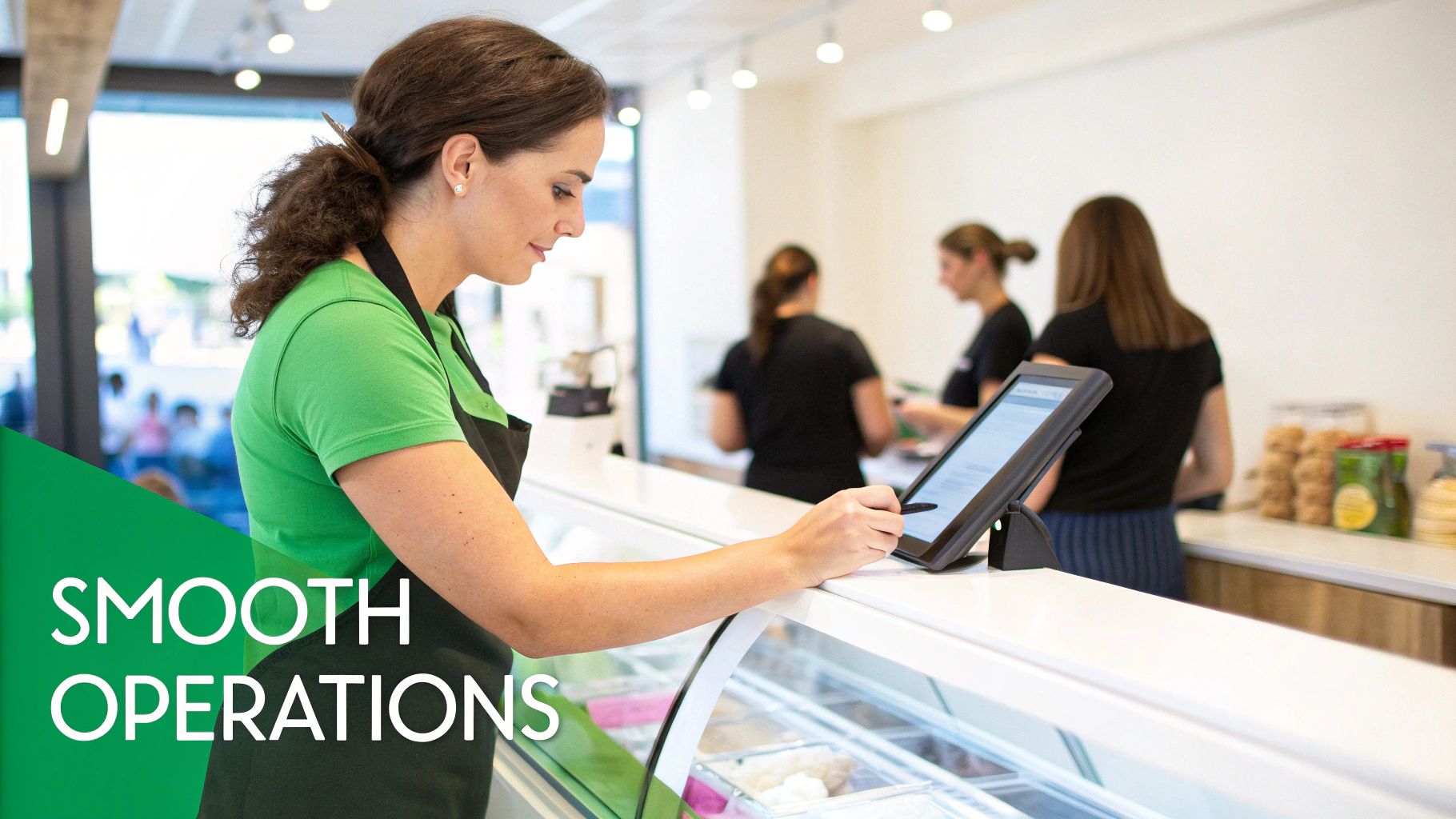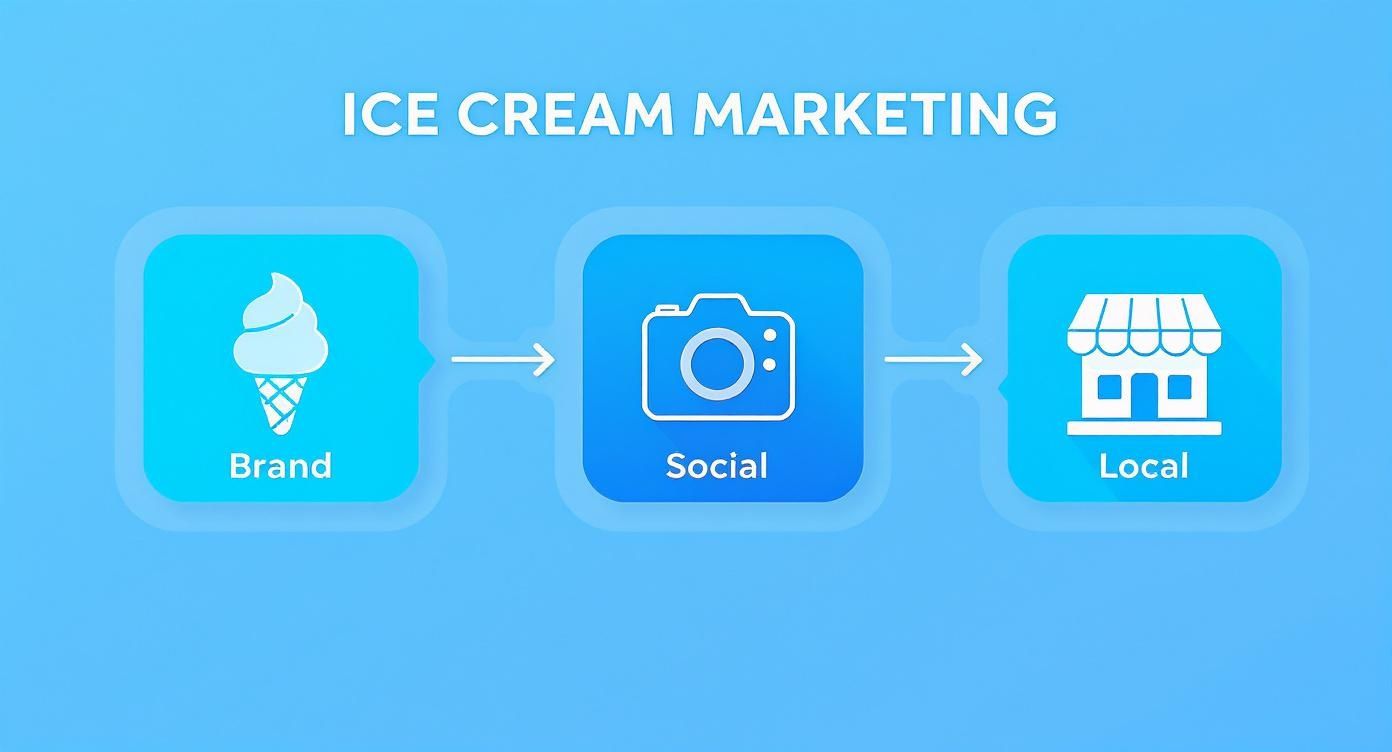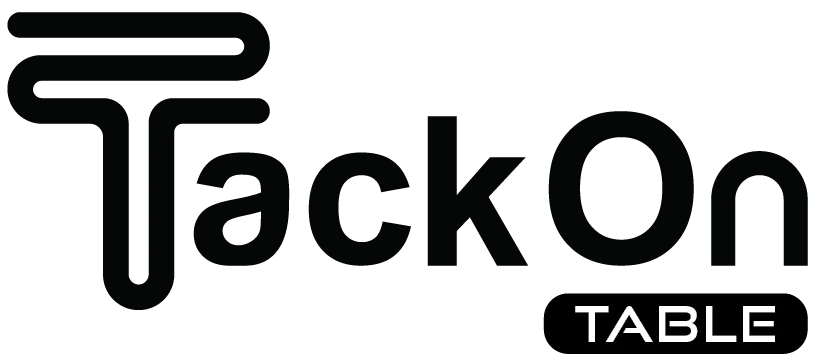Think of your ice cream shop business plan as your roadmap. It's the document that will not only help you get a loan but will also keep you on track as you grow. It’s where you prove to yourself, and to potential investors, that you’ve got a solid idea and a real plan to turn a profit.
Defining Your Shop’s Vision and Mission

Before you even start dreaming about flavor combinations and dipping cabinets, your ice cream shop business plan needs a soul. You have to nail down the "why" behind it all. Lenders see dozens of these plans. The ones that stand out are those with a compelling story and a clear, confident vision.
This first part of your plan, which often kicks off your executive summary, sets the tone for everything else. Forget corporate jargon. Your goal here is to paint a picture of the experience you want to create for every single person who walks through your door.
Crafting a Compelling Mission Statement
Your mission statement is your purpose, boiled down into a short, powerful sentence. It should clearly answer three core questions:
- What are you selling? (e.g., Handcrafted, small-batch ice cream)
- Who are you selling it to? (e.g., The families and dessert lovers in our neighborhood)
- How will you do it? (e.g., By using local ingredients and offering genuinely friendly service)
A good mission statement is both inspiring and grounded. For example, a shop focused on local sourcing might have a mission like: "To delight our community with artisanal ice cream made from sustainable, farm-to-cone ingredients." In one sentence, you've communicated your core values and what makes you different.
Identifying Your Unique Selling Proposition
What really makes your ice cream shop special? In a crowded market, you need a sharp, immediate answer. This is your Unique Selling Proposition (USP), and it's the foundation of your entire brand. Maybe you’re the only place in town with a full lineup of creative vegan flavors. Or perhaps you're bringing back the nostalgic charm of an old-fashioned soda fountain.
Your USP is the specific benefit a competitor can't easily copy. It’s the reason a customer will walk past another shop to get to yours. Find that one thing—whether it's flavor innovation, an incredible customer experience, or a deep community connection—and build your brand around it.
Here are a few ideas for a strong USP:
- Artisanal Focus: Using unique, high-quality ingredients like local honey, small-batch chocolate, or exotic spices.
- Dietary Inclusivity: Offering a deep menu of vegan, gluten-free, or low-sugar options that are just as good as the originals.
- Experience-Driven: Creating a themed atmosphere, like a retro '50s parlor or a sleek, modern dessert bar.
- Community Hub: Hosting local events, showcasing neighborhood artists, or partnering with other nearby small businesses.
Ultimately, your vision and mission will shape every single decision you make, from the menu to your marketing. This even includes the technology you choose. A modern, easy-to-use system like TackOn Table gives a growing shop the flexibility it needs without the high costs and complexity of systems like Toast or Clover. It ensures your day-to-day operations actually support your mission, right from the start.
Ready to see how the right tech can help bring your vision to life? Book a demo of TackOn Table today and find a simpler way to manage your dream shop.
Getting to Know Your Local Market and Competition
A fantastic idea for an ice cream shop is one thing, but making it a local favorite is another game entirely. Before you even think about signing a lease or buying a single freezer, you need to prove you understand the neighborhood you want to serve. This isn't just about crunching numbers; it’s about hitting the pavement and seeing your future spot through your customers' eyes.
The good news? People love ice cream. The global market was pegged at around $80-82 billion in 2024 and is expected to climb past $125 billion by 2033. That's a whole lot of scoops. You can read the full research on this expanding market here. While the global appetite is huge, your success will come down to how well you capture your little corner of the world.
Who Are You Scooping For?
First things first, you need to paint a clear picture of your ideal customer. Are you aiming to be the go-to spot for families with toddlers, the cool hangout for college students, or the sophisticated destination for professionals craving a gourmet treat? The answer changes everything, from your flavor list to your marketing flyers.
To get started, dig into these details:
- Age and Family Status: Is the area teeming with young singles, new families pushing strollers, or retirees enjoying their afternoons?
- Income Level: Can your neighbors afford premium, artisanal scoops, or will they be looking for great value and classic flavors?
- Lifestyle and Values: Are they health-nuts searching for vegan options, or are they after a classic, indulgent experience?
- Daily Rhythms: Where do they work, shop, and hang out? What does their daily routine look like?
Knowing this helps you build a shop that feels like it was made just for them. For instance, a spot near a high school could crush it with after-school BOGO deals. In contrast, a shop in an upscale shopping district might find its sweet spot with single-origin chocolate gelato and unique flavor pairings.
Sizing Up the Competition
Understanding your competition means more than just knowing their names. It’s time for a little undercover work to figure out what they do well, where they fall short, and what opportunities they’ve left wide open for you.
Put on your customer hat and visit every single competitor. While you're there, take some mental (or actual) notes:
- The Product: How’s the ice cream itself? What's the quality, texture, and flavor like? What are their best-sellers?
- The Vibe: Is the staff welcoming? Is the shop clean and a place you'd want to hang out? How long is the wait on a busy day?
- The Price Tag: Check the cost for a single scoop, a double, and any fancy sundaes. How does it stack up against your planned pricing?
- The Customers: Who’s actually buying from them? When are they slammed, and when is it a ghost town?
This isn't about stealing their ideas. It's about finding your unique angle. If every other shop closes at 9 PM, maybe there’s a real hunger for a late-night dessert spot. If nobody is offering seriously good dairy-free options, you’ve just found your golden ticket.
Carving Out Your Niche with the Right Café Management Software
Once you’ve put together your customer profile and competitor notes, you can clearly define your place in the market. This research is what will convince investors (and yourself) that you’re not just opening another ice cream shop—you’re launching a smart business designed to fill a specific local need.
This is also where the right tools can give you an immediate advantage. A modern café management software platform like TackOn Table helps you turn those insights into action. For example, if you noticed a competitor always has a massive line, imagine being able to bust your own line with a mobile POS. TackOn Table's straightforward setup and affordable price point make it one of the best Toast vs Clover alternatives for a new business that wants to be efficient from day one.
By blending solid market research with smart operational choices, you build a business plan that proves you’re ready to create a shop with staying power.
Ready to see how a simple, powerful POS can help you outshine the competition? Start your free trial of TackOn Table today.
Crafting A Profitable and Modern Menu

Your menu is the heart and soul of your ice cream shop. It's more than just a list of flavors; it's where your brand's personality shines, turning first-time visitors into regulars. A thoughtfully designed menu for your ice cream shop business plan is a powerful strategic tool, balancing crowd-pleasing classics with unique, shareable creations that generate both buzz and profit.
It all starts with quality ingredients. Sourcing premium dairy, fresh fruit, and decadent chocolates lays the groundwork for a product that speaks for itself. But today's customers expect more.
We're seeing a massive shift toward plant-based, low-sugar, and dairy-free options as people look for treats that align with their health-conscious lifestyles. Recent industry analysis highlights this evolution in consumer tastes. Offering compelling vegan or dairy-free flavors is no longer a niche strategy—it’s a business essential for reaching the widest possible audience.
Balancing The Classics With Creative Twists
A knockout menu finds that sweet spot between comforting familiarity and exciting discovery. You absolutely have to nail the classics, but your unique creations are what will get people talking and sharing online.
- Core Classics: Perfect your recipes for vanilla, chocolate, strawberry, and cookies & cream. These will be your workhorses, the foundation for sundaes, milkshakes, and satisfied smiles.
- Signature Flavors: Get creative and develop 3-5 unique flavors that tell your shop’s story. Think Lavender Honey, Spicy Mango Sorbet, or a Cereal Milk creation. These are your Instagram-worthy head-turners.
- Rotational and Seasonal Specials: Keep things fresh with limited-time offerings. A Pumpkin Spice in the fall or Peppermint Bark during the holidays creates a sense of urgency and gives regulars a reason to keep coming back.
Calculating Your Cost Per Scoop and Setting Prices
Profitability lives and dies by the numbers. Simply guessing at prices is a recipe for disaster. You have to calculate your Cost of Goods Sold (COGS) for every single item you sell. This means breaking down the precise cost of every ingredient in a batch—from the cream and sugar to the flavorings and mix-ins.
Once you know the cost to produce a batch, you can figure out your cost per scoop. A healthy target food cost percentage for an ice cream shop is between 20% and 30%.
Pro Tip: If a three-gallon tub costs you $30 in ingredients and yields 60 scoops, your cost per scoop is $0.50. To hit a 25% food cost, you’d price that scoop at $2.00 ($0.50 / 0.25).
Here’s a simple table to visualize how you'd break down the cost for a signature flavor to arrive at a profitable retail price.
Sample Menu Item Cost and Pricing Breakdown
| Ingredient | Cost per Unit | Amount per Serving | Cost per Serving | Retail Price (at 25% Food Cost) |
|---|---|---|---|---|
| Ice Cream Base (4 oz) | $0.12/oz | 4 oz | $0.48 | |
| Caramel Swirl (0.5 oz) | $0.20/oz | 0.5 oz | $0.10 | |
| Toasted Pecans (0.25 oz) | $0.40/oz | 0.25 oz | $0.10 | |
| Waffle Cone (1 cone) | $0.25/cone | 1 cone | $0.25 | |
| Total | $0.93 | $3.72 (Aim for $3.75) |
This calculation is critical for everything from a simple scoop to your most elaborate sundae. Doing this by hand is a ton of work, which is why a good POS system with strong inventory management features is a game-changer. It can track your ingredient levels in real-time and automatically show you which menu items are most profitable.
Driving Profit With Smart Menu Engineering
The way you design your menu can subtly guide customers toward your most profitable items. Think about offering combo deals (like a scoop and a drink for one price) or simple upsells (like a waffle cone for an extra dollar) to increase your average ticket size.
Your menu isn't just a list; it's a powerful engine for your shop's financial health. By truly understanding your costs and catering to modern tastes, you'll turn it into your single biggest asset.
Using a Modern POS System to Run a Smarter Shop

A killer ice cream recipe is just the start. The real secret to a successful shop is what happens behind the counter. Your business plan needs to show investors you have a solid grip on the day-to-day operations—from handling the summer rush to tracking every last ounce of fudge ripple.
Getting your tech stack right from day one saves a world of headaches later. While big names like Toast and Clover are out there, they can be overkill (and overpriced) for a brand-new shop. A modern, nimble alternative like TackOn Table is your secret weapon, designed for affordability, simplicity, and adaptability.
The Advantage of an All-in-One Restaurant POS
As a new ice cream shop owner, your time is your most valuable asset. The last thing you need is to be wrestling with separate systems for payments, inventory, and scheduling. An all-in-one Restaurant POS pulls all these critical jobs into one place, giving you a live, honest look at how your business is doing at any moment.
This integrated approach lets you:
- See Your Sales in Real-Time: Instantly spot which flavors are flying out the door and which are just sitting in the freezer. That's data you can use to refine your menu on the fly.
- Automate Inventory: The system can automatically deduct ingredients with every scoop sold and ping you when you're running low on waffle cones or rainbow sprinkles.
- Handle Staffing with Ease: Track employee hours, check in on performance, and manage permissions from a single dashboard.
- Make Payments Painless: Take credit cards, mobile payments, and cash without a hitch, keeping lines moving and customers happy.
When all these functions talk to each other, you cut out the tedious manual work that drags so many new businesses down. You can spend less time buried in spreadsheets and more time training your team or chatting with your regulars.
A system like TackOn Table was built for this. It's designed to be so intuitive you can get it up and running in under 30 minutes—no IT degree required. This unique simplicity and affordability makes it one of the smartest Toast vs Clover alternatives for entrepreneurs who need to stay lean.
Beat the Rush with a Mobile POS
Picture it: a blistering July afternoon and a line snaking out your front door. A clunky, stationary cash register is a bottleneck waiting to happen. It frustrates customers and can even cost you sales from people who aren't willing to wait.
This is where a mobile POS completely changes the game.
TackOn Table’s mobile POS feature gives your staff handheld devices to take orders and payments anywhere—in the middle of the line, out on the patio, wherever your customers are. It's the ultimate line-buster for those peak seasonal rushes, turning potential frustration into a smooth, fast experience.
Plan for Growth with Multi-Location Control
Your business plan shouldn't just be about opening day; it should map out your future. What happens when your first shop is a runaway hit and you're ready to open a second? A POS that can't handle multiple locations will quickly turn your dream into a logistical nightmare.
Modern Café Management Software is built for growth. A platform like TackOn Table provides seamless multi-location control, allowing you to:
- Control Menus Everywhere: Add a seasonal pumpkin spice flavor or update pricing across all your shops from one account.
- Unify Your Reporting: Easily compare sales, inventory, and staff performance between locations to see what's working and where you can improve.
- Standardize Your Brand: Apply the same operational settings and workflows to every new shop, ensuring customers get the same great experience no matter which one they visit.
Building this scalability into your plan shows investors you're not just thinking about one shop—you're building an empire. By choosing an affordable, all-in-one POS system from the start, you prove you're building a smart, sustainable, and profitable business.
Creating Your Marketing and Sales Playbook
Let's be honest—even the most incredible, creamiest ice cream on the planet won't sell itself. A smart marketing and sales strategy, clearly laid out in your ice cream shop business plan, is what will turn your delicious product into a local legend. This isn't just about ads; it's about building a community, creating a buzz before you even open, and giving people a reason to come back again and again.
It all starts with your brand identity. This goes way beyond a fun name and a slick logo. It’s the entire vibe of your shop. Are you a cheerful, family-friendly spot with bubblegum colors and classic rock playing? Or are you more of a sleek, modern dessert bar known for adventurous, artisanal flavors? Every single marketing choice you make, from your Instagram posts to your napkin color, should echo this identity.
Building Your Digital Footprint
These days, your online storefront is just as critical as your physical one. Social media is your best friend here, especially visual platforms like Instagram and TikTok. They were practically made for showing off vibrant scoops, over-the-top sundaes, and happy customers with chocolate-smeared smiles. Your phone and some good lighting are your most powerful tools.
Get people talking and tapping that "follow" button by:
- Running fun contests. "Post a pic with your cone and tag us to win a free pint!" is a classic for a reason.
- Showing the magic. Post short videos of you churning a new flavor or adding the fudge swirl. People love a behind-the-scenes peek.
- Collaborating with local food bloggers or influencers. A glowing review from a trusted voice can send a line of new customers to your door.
Beyond social media, a clean, simple website is non-negotiable. It's the home base for your menu, hours, and story. More importantly, it's a gateway to another stream of income. Integrating a system for online pickup and delivery orders is a game-changer. Suddenly, you're not just serving walk-ins; you're catering to busy families and office lunch orders. See how a simple online ordering platform can capture more sales right from the start.
Driving Sales with Local and Seasonal Strategies
While a solid digital game is crucial, never forget the power of old-school, boots-on-the-ground marketing. Hyper-local strategies are gold for a business like an ice cream shop that thrives on neighborhood foot traffic.
The goal is to become a neighborhood institution, not just another shop. This means weaving your brand into the fabric of the community and building real relationships with customers and other local businesses.
Here are a few low-cost, high-impact ideas to get you started:
- Local Partnerships: Chat with the pizza place down the street about a "dinner and dessert" coupon swap.
- Community Sponsorship: Put your shop's name on the back of a little league team's jerseys or sponsor a school fun run. You'll get your brand in front of hundreds of local families.
- Loyalty Programs: A simple punch card still works wonders. A modern Restaurant POS system often has digital rewards built right in, making it incredibly easy to track and manage.
Beating the Off-Season Slump
The elephant in the room for any ice cream shop is seasonality. Your business plan has to have a solid answer for the inevitable question: "What happens when it gets cold?" Instead of dreading winter, think of it as a chance to get creative and offer something unique.
You can easily pivot your menu to keep the doors swinging:
- Hot Chocolate Floats: Use your signature ice cream to create an unforgettable winter treat.
- Warm Baked Goods: Nothing beats a warm, gooey brownie or a fresh cookie served à la mode.
- Holiday Flavors: Think seasonal specials like peppermint bark, gingerbread, or eggnog. These limited-time offerings create a sense of urgency.
Hosting in-shop events can also be a huge draw during the slower months. Imagine a holiday cookie decorating workshop, a tasting night for your new winter flavors, or a cozy board game night. These strategies do more than just make sales—they keep your shop top-of-mind all year long, ensuring a steady flow of happy customers.
Ready to build a loyal customer base with smart, simple tools? Book a demo of TackOn Table to see how our all-in-one platform can help manage your marketing, sales, and operations effortlessly.
Forecasting Realistic Startup Costs and Financials
This is where your sweet dream meets the bottom line. A fantastic concept and mouth-watering recipes are the fun part, but the financial section of your ice cream shop business plan is what proves you have a real, sustainable business on your hands. It’s time to shift from flavors to figures and ground your passion in solid numbers.
Investors—and you, for that matter—need to see a financial roadmap that's clear, conservative, and well-researched. This means getting granular with every single anticipated cost and projecting your path to profitability. A fuzzy or wildly optimistic forecast is a huge red flag, so attention to detail is your best friend here.
Estimating Your Startup Costs
Before you serve your first scoop, you'll be spending money to get the doors open. Startup costs cover everything from freezers to your first tubs of vanilla, and they can swing dramatically based on your shop's location, size, and style. The key is to map out all these one-time expenses to build a realistic budget.
Here’s a look at what you’ll be paying for:
- The Big-Ticket Equipment: This is often your largest category. Think dipping cabinets, blast freezers, walk-in coolers, commercial mixers, and, of course, a reliable point-of-sale system.
- Location Build-Out: This covers the cost of transforming an empty space into your dream shop. It includes everything from plumbing and electrical work to installing countertops and making sure you meet all health codes.
- Permits and Licenses: Getting the green light from the city and health department is non-negotiable. Factor in business licenses, health permits, and food handler certifications.
- Initial Inventory: Your first big order of dairy, sugar, flavorings, cones, cups, sprinkles, and everything else needed to stock your kitchen and front counter.
- Professional Fees: It's smart to budget for an attorney to look over your lease and an accountant to help get your bookkeeping in order from day one.
My Two Cents: Always, and I mean always, add a contingency fund of at least 15-20% to your startup budget. Unexpected costs aren't a possibility; they're a guarantee. That buffer can be the lifeline that gets you through a surprise repair or a delayed opening without derailing your entire launch.
To help you get started, here's a breakdown of what you might expect to spend. These are just estimates, of course—your actual costs will depend heavily on your specific location and choices.
Estimated Startup Costs for an Ice Cream Shop
| Expense Category | Estimated Cost Range (Low End) | Estimated Cost Range (High End) | Notes |
|---|---|---|---|
| Equipment | $20,000 | $50,000+ | Includes freezers, POS, mixers, etc. Can save money with used equipment. |
| Lease & Renovations | $10,000 | $75,000 | Highly variable based on location and the condition of the space. |
| Initial Inventory | $3,000 | $8,000 | Covers dairy, sugar, flavorings, cones, cups, and toppings. |
| Licenses & Permits | $500 | $2,000 | Fees for business license, health permits, food handler cards. |
| Professional Fees | $1,000 | $5,000 | Legal fees for lease review, accounting setup. |
| Initial Marketing | $2,000 | $6,000 | Grand opening promotions, signage, local ads, social media campaigns. |
| Contingency Fund (15%) | $5,500 | $22,000 | A crucial buffer for unexpected expenses that will come up. |
| TOTAL | $42,000 | $168,000+ |
This table gives you a ballpark, but doing your own local research is the only way to get truly accurate numbers for your plan.
Building Your Financial Projections
Once you have a handle on startup costs, it's time to forecast your financial performance. You'll want to map out the first three years to show investors how you plan to make money and manage it wisely.
This story is told through three essential financial statements:
- Sales Forecast: This is your best educated guess on how much ice cream you'll sell. Don't just pull numbers out of thin air. Base them on your location's foot traffic, your shop's seating capacity, and seasonal demand (hello, summer!). It’s best to project sales month-by-month for the first year, then switch to quarterly for years two and three.
- Profit and Loss (P&L) Statement: Often called an income statement, the P&L shows your projected revenue minus your ongoing costs and expenses to arrive at your net profit. This is where you'll account for recurring costs like rent, utilities, payroll, marketing, and the cost of goods sold.
- Cash Flow Projection: This might be the most critical document of the three. It tracks the actual cash coming into and going out of your business bank account. It's vital for making sure you always have enough money on hand to pay your staff and your suppliers, even during the slow winter months.
This infographic breaks down how your marketing efforts directly fuel the sales figures in your financial plan.

As you can see, a strong brand, active social media, and smart local outreach all work together to build a loyal customer base and, ultimately, drive the revenue that makes your financial projections a reality.
Finding Your Break-Even Point
Finally, you need to calculate your break-even point. This simple but powerful analysis tells you the exact amount of sales you need to make each month just to cover all your costs. It’s the magic number where you're not losing money, but you're not yet turning a profit.
Knowing this number gives you a clear, tangible sales target to aim for every single day. For investors, it demonstrates that you have a firm grasp of your shop's financial engine and know exactly what it takes to succeed.
Tackling these financial documents can feel intimidating, but you don't have to do it with a spreadsheet and a calculator alone. A modern Restaurant POS like TackOn Table can be a game-changer. It automatically tracks every sale, giving you the hard data you need to build accurate forecasts. Because it’s an all-in-one platform, your sales, inventory, and labor costs are all in one place, painting a crystal-clear financial picture without the hassle of juggling multiple systems. For a new shop trying to run lean and smart, that kind of integrated insight is invaluable.
Frequently Asked Questions (FAQs)
How much does it cost to start an ice cream shop?
The cost varies widely, from around $42,000 on the low end to over $168,000 for a larger, high-end shop. Key factors include your location’s rent, the extent of renovations needed, and whether you buy new or used equipment. A detailed financial forecast in your business plan is essential for an accurate budget.
What is the profit margin for an ice cream shop?
A well-run ice cream shop can have a gross profit margin of around 60-70% on menu items. However, your net profit margin (after rent, labor, and all other expenses) will typically be closer to 10-20%. A smart POS system like TackOn Table helps maximize profitability by tracking ingredient costs and identifying your most profitable flavors.
What kind of software do I need for an ice cream shop?
At a minimum, you need a reliable Point of Sale (POS) system. The best solutions are all-in-one platforms that also manage inventory, track sales data, handle online orders, and offer features like mobile ordering to speed up service. TackOn Table provides all these tools in a simple, affordable package designed for businesses like yours.
Turn Your Ice Cream Dream into a Reality
Crafting a detailed ice cream shop business plan is the first, most crucial step in launching your business. By thoroughly researching your market, defining your unique brand, and making smart technology choices, you set yourself up for long-term success.
Ready to see how an all-in-one platform can simplify your operations from day one? TackOn Table offers the mobile POS, easy setup, multi-location control, and affordability you need to thrive.
Start your free trial today or book a demo to discover a better way to run your shop.



